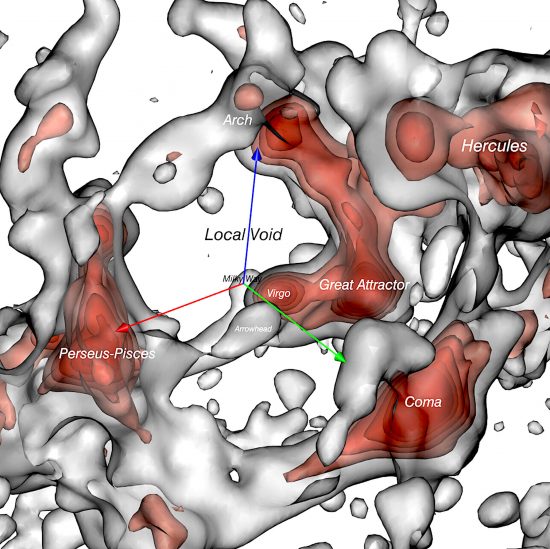
Jul 26, 2019
Conventional redshift observations seems to indicate that the Universe is expanding faster today than it did in the past.
As written in a previous Picture of the Day, “dark energy” is a force that is thought to drive the expansion of the Universe. However, like “dark matter” it cannot be detected with any instrument. Rather than acknowledging problems with the theories, astronomers resort to increasingly arcane ideas about matter distribution. One example of their ideas is that space is expanding, so all cosmic structures are in motion relative to that expansion.
Recently, researchers from the University of Hawaii suggested that half of that motion comes from the Virgo Cluster’s massive gravity, along with the “…expansion of the Local Void as it becomes ever emptier.”
A previous Picture of the Day commented on the discovery of a “cosmic void” based on the detection of a lower temperature region in space. The void extends for more than a billion light-years, as astronomers reckon distance. It is those voids, and the pull from superclusters, that lead astrophysicists to believe they can confirm dark energy’s existence.
Density variations in the Universe are said to increase the gravitational energy imparted to microwave emissions from deep space. Conversely, lower density regions are thought to weaken the signals, because there is reduced mass. Looking at microwave signals from telescopes like the Very Large Array, there appears to be a wide expanse where microwave radiation possesses a larger energy curve than it should exhibit. The problems associated with the Cosmic Microwave Background are not the topic of this paper. Suffice to say, what was thought to be radiation from deep space is really radiation from Earth’s oceans.
Nobel laureate, Sal Perlmutter, is quoted as saying: “The Universe is made mostly of dark matter and dark energy and we don’t know what either of them is.”
Two of the most active phenomena in astrophysics could be false premises. On the other hand, plasma makes up 99.99% of the Universe. It is a fascinating convergence that the volume of gravitational mass invented to save Big Bang cosmology is the same as the mass of plasma that is overlooked. In an Electric Universe, electricity drives galaxies and their associated stars. Birkeland currents have a longer-range attractive force than gravity by several orders of magnitude, diminishing with the square root of the distance from the current axis – which could account for the anomalous movement of stars as they revolve around the galactic core, as well as the anomalous acceleration of galaxies in deep space.
Instead of accepting that “anomalies” exist because the Big Bang theory is faulty, astronomers resort to the absurd idea that space can be pulled, twisted, or stretched.
As physicist and Electric Universe pioneer, Hannes Alfvén said:
“I have never thought that you could obtain the extremely clumpy, heterogeneous universe we have today, strongly affected by plasma processes, from the smooth, homogeneous one of the Big Bang, dominated by gravitation.” (From A. L. Peratt, “Dean of the Plasma Dissidents”, Washington Times, supplement: The World and I, May 1988)
Stephen Smith












